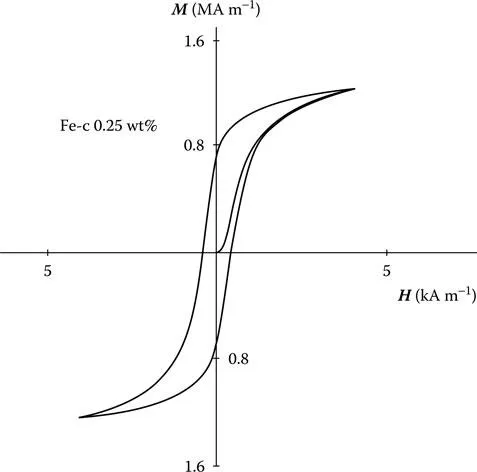
eBook - ePub
Introduction to Magnetism and Magnetic Materials
David Jiles
This is a test
Partager le livre
- 626 pages
- English
- ePUB (adapté aux mobiles)
- Disponible sur iOS et Android
eBook - ePub
Introduction to Magnetism and Magnetic Materials
David Jiles
Détails du livre
Aperçu du livre
Table des matières
Citations
À propos de ce livre
A long overdue update, this edition of Introduction to Magnetism and Magnetic Materials is a complete revision of its predecessor. While it provides relatively minor updates to the first two sections, the third section contains vast updates to reflect the enormous progress made in applications in the past 15 years, particularly in magnetic recordin
Foire aux questions
Comment puis-je résilier mon abonnement ?
Il vous suffit de vous rendre dans la section compte dans paramètres et de cliquer sur « Résilier l’abonnement ». C’est aussi simple que cela ! Une fois que vous aurez résilié votre abonnement, il restera actif pour le reste de la période pour laquelle vous avez payé. Découvrez-en plus ici.
Puis-je / comment puis-je télécharger des livres ?
Pour le moment, tous nos livres en format ePub adaptés aux mobiles peuvent être téléchargés via l’application. La plupart de nos PDF sont également disponibles en téléchargement et les autres seront téléchargeables très prochainement. Découvrez-en plus ici.
Quelle est la différence entre les formules tarifaires ?
Les deux abonnements vous donnent un accès complet à la bibliothèque et à toutes les fonctionnalités de Perlego. Les seules différences sont les tarifs ainsi que la période d’abonnement : avec l’abonnement annuel, vous économiserez environ 30 % par rapport à 12 mois d’abonnement mensuel.
Qu’est-ce que Perlego ?
Nous sommes un service d’abonnement à des ouvrages universitaires en ligne, où vous pouvez accéder à toute une bibliothèque pour un prix inférieur à celui d’un seul livre par mois. Avec plus d’un million de livres sur plus de 1 000 sujets, nous avons ce qu’il vous faut ! Découvrez-en plus ici.
Prenez-vous en charge la synthèse vocale ?
Recherchez le symbole Écouter sur votre prochain livre pour voir si vous pouvez l’écouter. L’outil Écouter lit le texte à haute voix pour vous, en surlignant le passage qui est en cours de lecture. Vous pouvez le mettre sur pause, l’accélérer ou le ralentir. Découvrez-en plus ici.
Est-ce que Introduction to Magnetism and Magnetic Materials est un PDF/ePUB en ligne ?
Oui, vous pouvez accéder à Introduction to Magnetism and Magnetic Materials par David Jiles en format PDF et/ou ePUB ainsi qu’à d’autres livres populaires dans Sciences physiques et Matière condensée. Nous disposons de plus d’un million d’ouvrages à découvrir dans notre catalogue.
Informations
Section II
Magnetism in Materials
Magnetic Phenomena on the Microscopic Scale
5 Magnetic Properties
We will now look at the causes of hysteresis in ferromagnets and how the variation of magnetization with magnetic field can be quantified in restricted cases such as at low field and in the approach to saturation. High-resolution measurements of the variation of M with H indicate that there are discontinuities. This is known as the Barkhausen effect. We will also consider the change in length of a ferromagnet as it is magnetized, that is, the magnetostriction, and discuss anisotropy in relation to magnetostriction.
We have shown in the previous chapter that most of the important macroscopic magnetic properties of ferromagnets can be represented on a B-H plot or hysteresis loop. From this, the magnetization can be calculated at every point on the hysteresis curve using the general formula B = μ0(H + M). As the magnetization curve is traversed, there are discontinuous, irreversible changes in the magnetization known as the Barkhausen effect after its discoverer. In recent years, the Barkhausen effect has become an important tool for investigating the microstructural properties of ferromagnetic materials.
One important bulk property of interest, which is not contained in the hysteresis plot, is the magnetostriction. This is the change in length of a material either as a result of a magnetic order (spontaneous magnetostriction) or under the action of a magnetic field (field-induced magnetostriction). This will also be discussed in this chapter.
5.1 HYSTERESIS AND RELATED PROPERTIES
5.1.1 INFORMATION FROM THE HYSTERESIS CURVE
Which are the most important macroscopic magnetic properties of ferromagnets?
From the hysteresis curve such as the one shown in Figure 5.1, we can define a number of magnetic properties of the material, which can be used to characterize the hysteresis loop. A question immediately arises: How many degrees of freedom are there in a hysteresis loop? Or to put the question another way: How many parameters are needed to characterize a hysteresis loop? Clearly, there is no general answer to this, but for the commonly encountered sigmoid-shaped hysteresis loop such as the one in Figure 5.1, we can start to enumerate the important properties and thereby make an estimate.

5.1.2 PARAMETRIC CHARACTERIZATION OF HYSTERESIS
Which are the parameters that can be used to define hysteresis?
First of all, the saturation magnetization M0 will give us an upper limit to the magnetization that can be achieved. At temperatures well below the Curie point, the technical saturation Ms can be used instead. The width of the loop across the H axis, which is twice the coercivity Hc, is also an independent parameter since this can be altered by heat treatment and hence is not dependent on Ms. The height of the curve along the B-axis, that is, the remanence is also an independent parameter since it is not wholly dependent on Ms and Hc. The orientation of the hysteresis curve on the B-H plane, which can be represented by , the slope of the curve at the coercive point, is also independent of the other parameters.
The hysteresis loss WH may also be an independent parameter as may the initial permeability . Finally, the curvature of the sides of the hysteresis loop, which although not immediately obvious as an independent parameter, is clearly not dependent on factors such ...